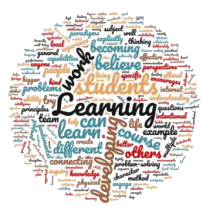Guiding Principles
 Maricopa’s Excellence in Teaching and Learning Guiding Principles provide an overarching framework for defining who we are and how we engage students in transformative ways.
Maricopa’s Excellence in Teaching and Learning Guiding Principles provide an overarching framework for defining who we are and how we engage students in transformative ways.
We actualize these principles at GCC by committing to create learning environments that align with GCC’s institutional values and intentionally move students toward the achievement of our institutional learning outcomes.
Because we value LEARNING, our learning environments ...
- Provide comprehensive and transformative experiences that help students achieve their personal, academic, and career goals
- Spark intrinsic interest in course content and challenge students through problem-solving, analyzing, synthesizing, and evaluating ideas
- Assume intelligence and abilities can grow with experience
- Engage students in hypothesizing and then testing their conceptual understanding
- Teach students to create and assess different types of information and ways of knowing
- Encourage students to take risks, receive feedback, and build resilience to try again
Because our learning environments are designed in this way, our students are able to demonstrate critical and creative thinking skills as well as quantitative reasoning and analysis.
Because we value QUALITY, our learning environments …
- Assure excellence in instruction and support services and continuous assessment for optimal results
- Engage students in deep learning in which they challenge their existing paradigms to evaluate the merit of their own ways of thinking
- Encourage students to take responsibility and self-regulate their own learning so the quality of their educational experiences extend beyond an individual class
- Provide students opportunities to test their understanding and apply their knowledge through real-world experiences
Because our learning environments are designed in this way, our students are able to demonstrate information literacy.
Because we value INTEGRITY, our learning environments …
- Demonstrate unwavering commitment to honesty, transparency, and accountability
- Ensure fair and honest consideration of student work
- Encourage students to strive to be the best students they can be both in terms of character and commitment
- Provide students a sense of control over and responsibility for their own learning
- Help students develop ethical principles and an understanding of the world
around them
Because our learning environments are designed in this way, our students are able to demonstrate responsible decision-making that leads to personal and community well-being.
Because we value COMMUNITY, our learning environments …
- Foster a culture that enables positive relationships based on mutual respect, trust, and a sense of belonging
- Ensure students believe we have confidence in their ability to learn and they believe that they can learn
- Afford opportunities for students to collaborate with other learners who are struggling with the same problems
- Encourage teamwork and an understanding of how students can share their skill set with others at multiple levels of society (locally, nationally, and globally)
- Cultivate student understanding of the importance of being a responsible citizen
Because our learning environments are designed in this way, our students are able to demonstrate the communication skills necessary for effective oral, written, and visual communication.
Because we value being FUTURE-FOCUSED, our learning environments …
- Enhance innovative and forward-thinking perspectives and approaches to prepare students for evolving educational, workforce, and societal needs
- Pose significant, encompassing, important questions to challenge students with relevant learning that prepares them to address problems impacting their lives, their work, and the world around them
- Engage students in inventing ways to solve problems
- Prepare students to be self-directed, intentional, life-long learners
- Assist students in acquiring leadership skills and the ability to manage complex projects
Because our learning environments are designed in this way, our students are able to clarify their career goals and demonstrate the knowledge and skills needed for success in the workplace.
References:
Bain, K. (2004). What the best college teachers do. Cambridge, Mass: Harvard University Press .
Fink, L. D. (2013). Creating significant learning experiences: An integrated approach to designing college courses. San Francisco, Calif: Jossey-Bass.